
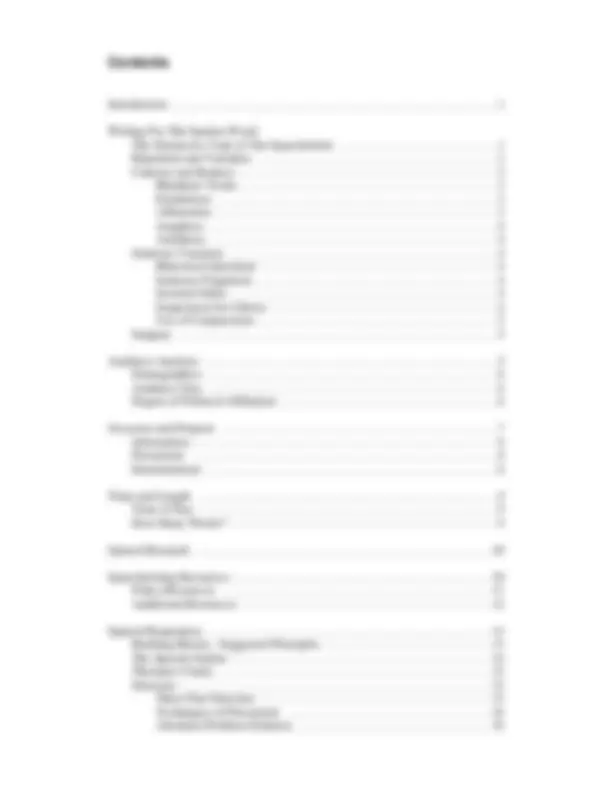
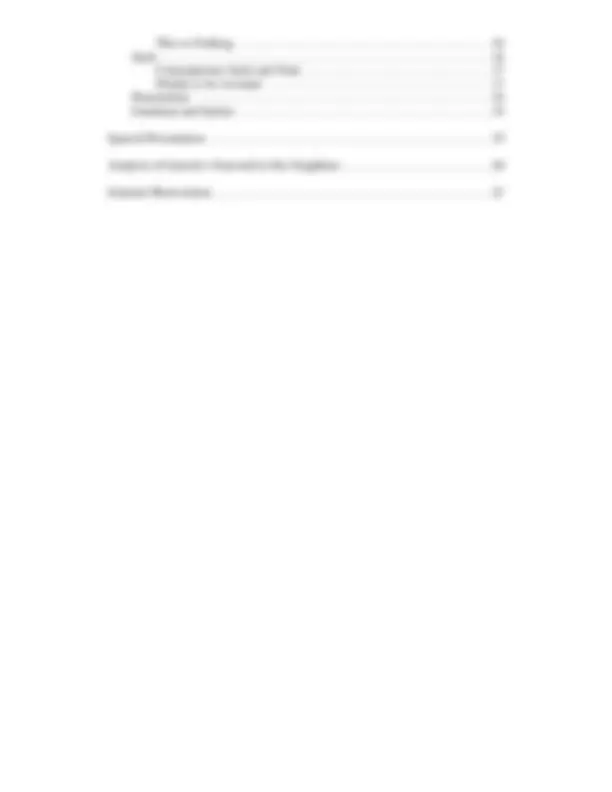
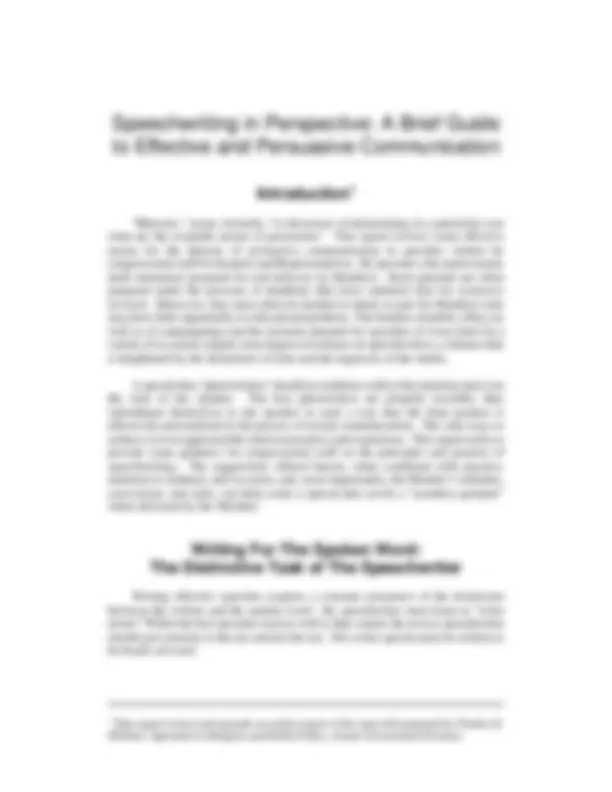
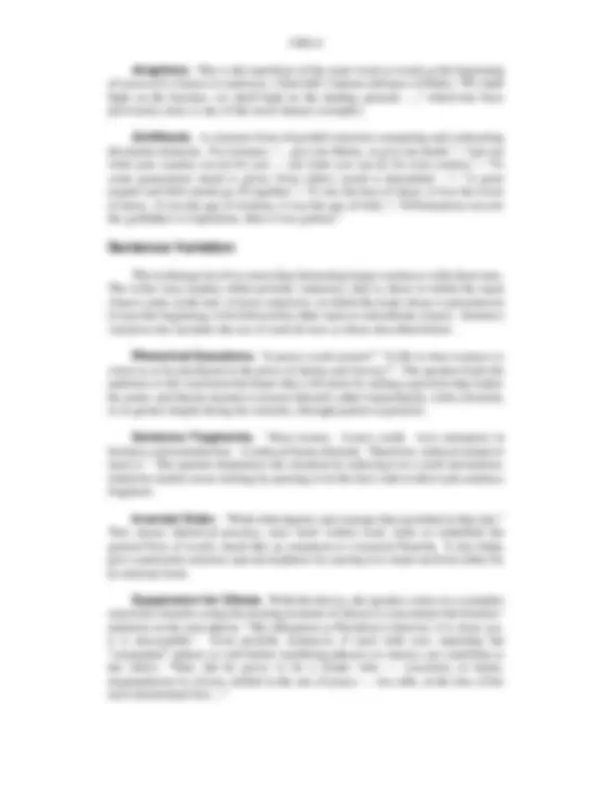
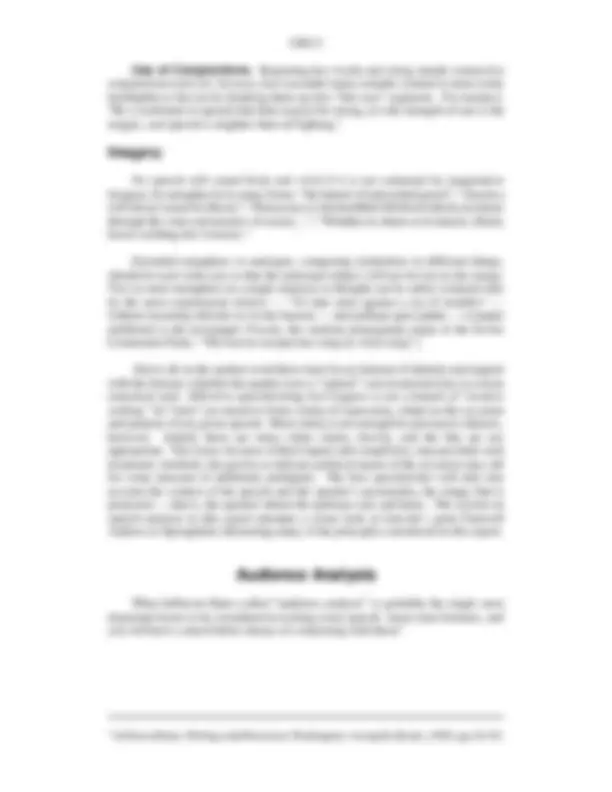
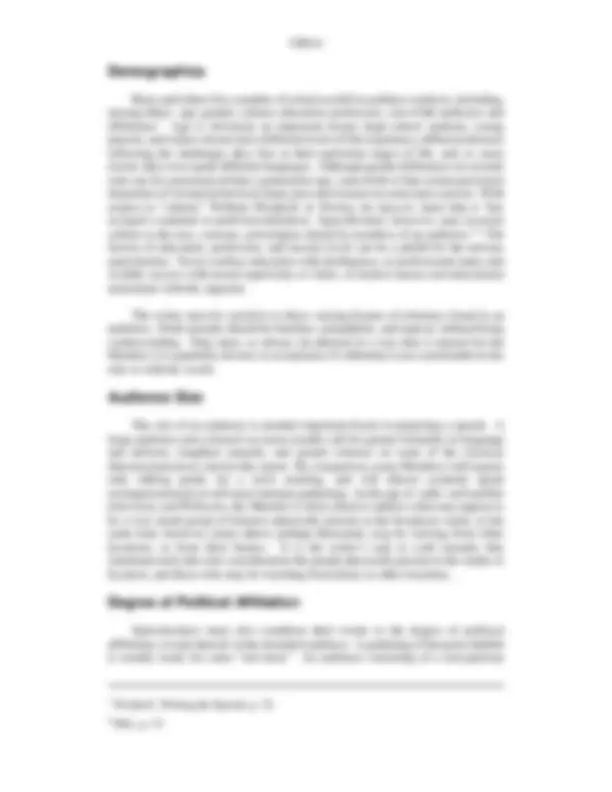
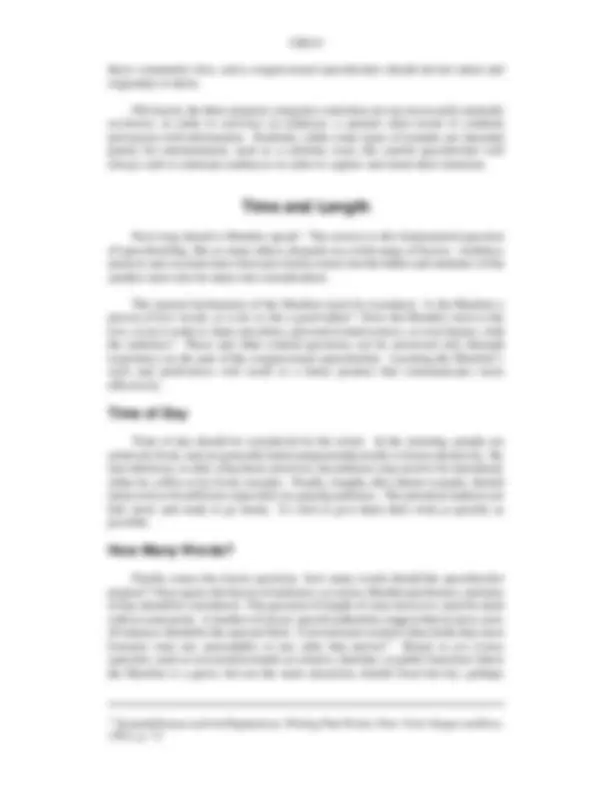
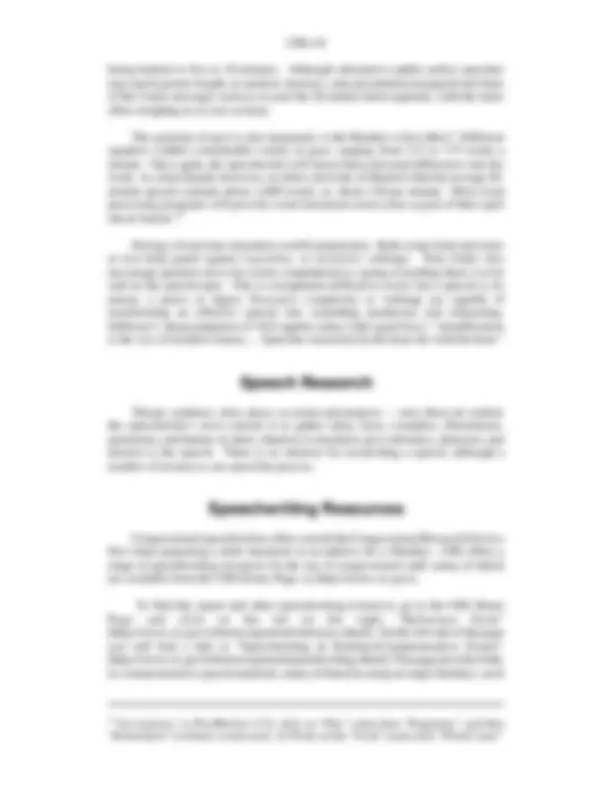
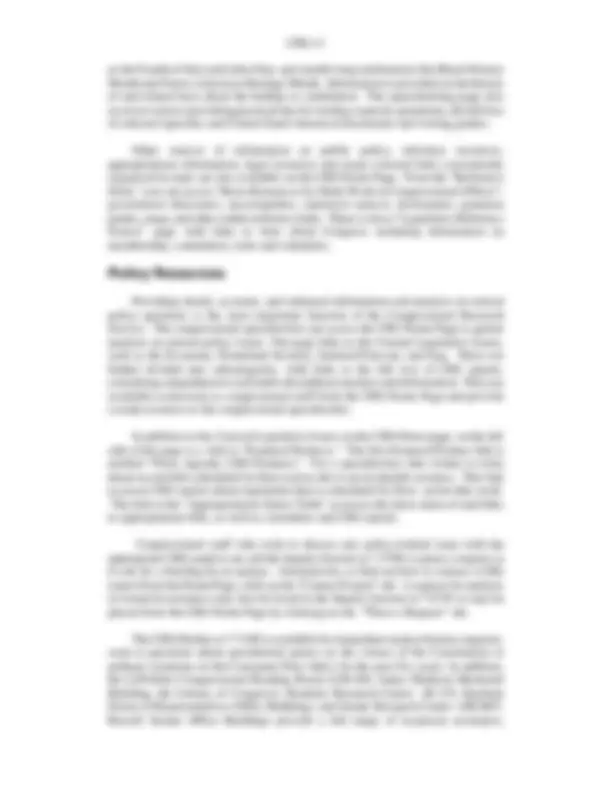
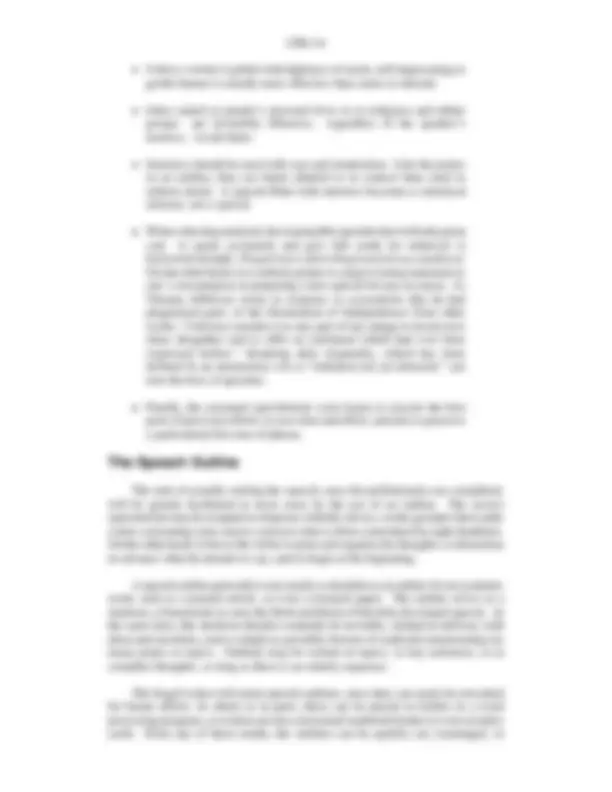
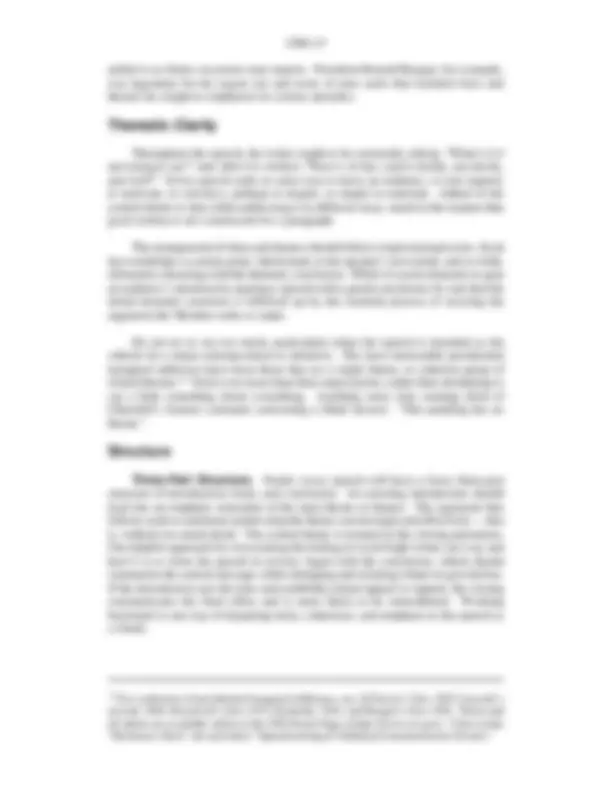
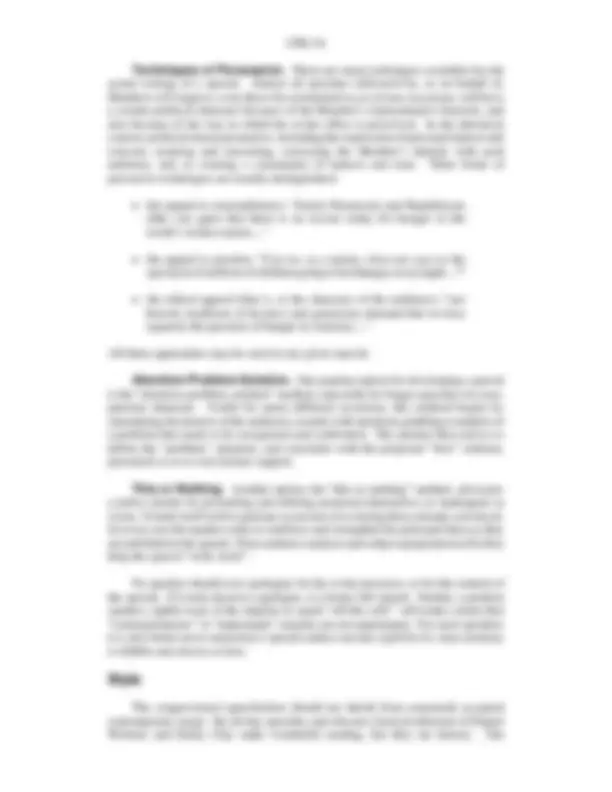
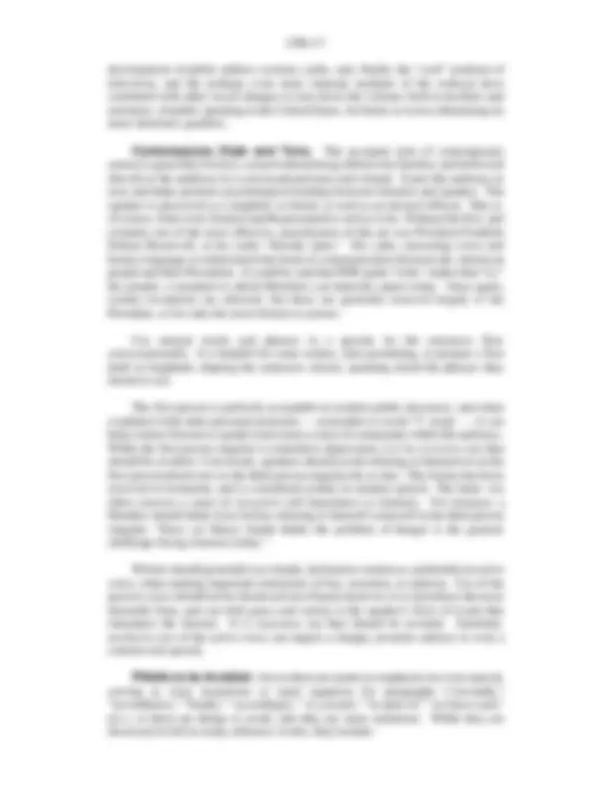
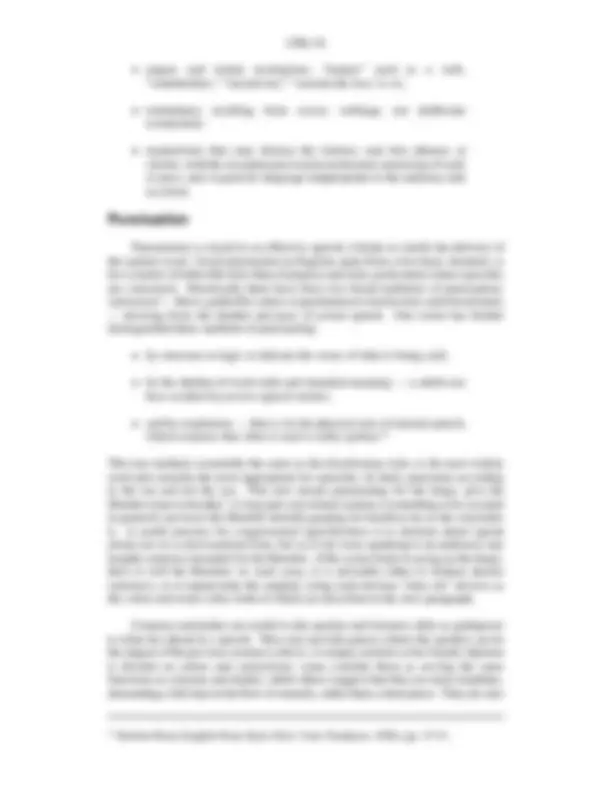
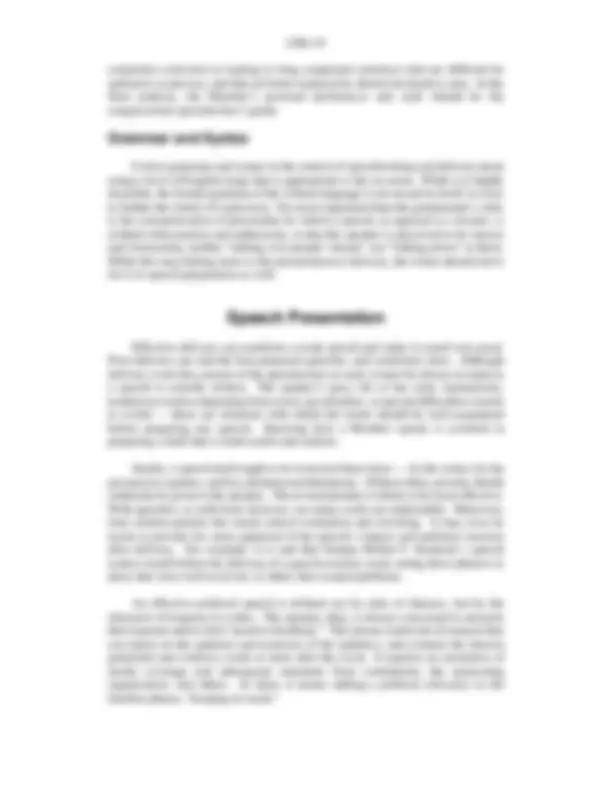
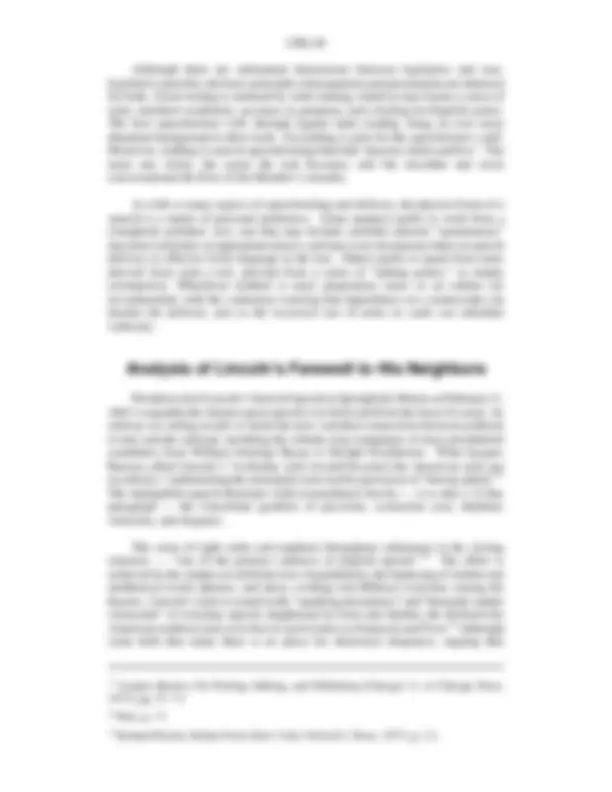
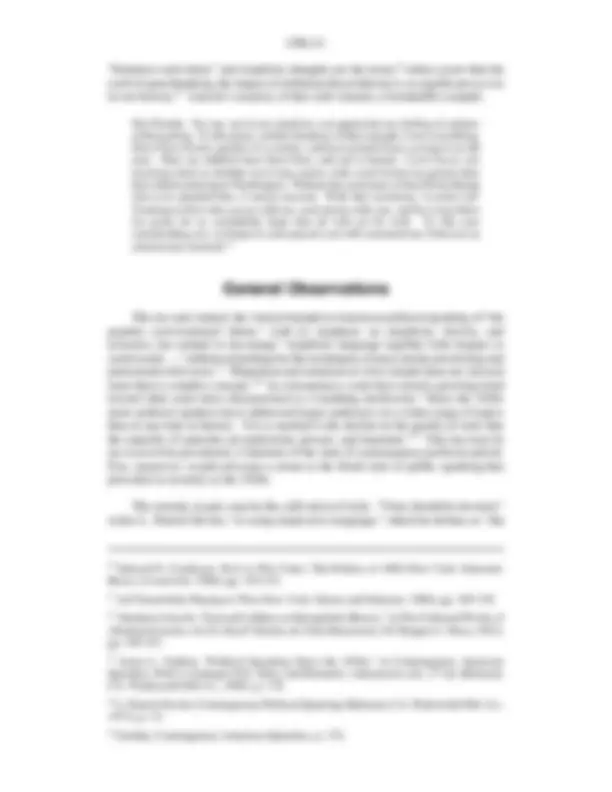
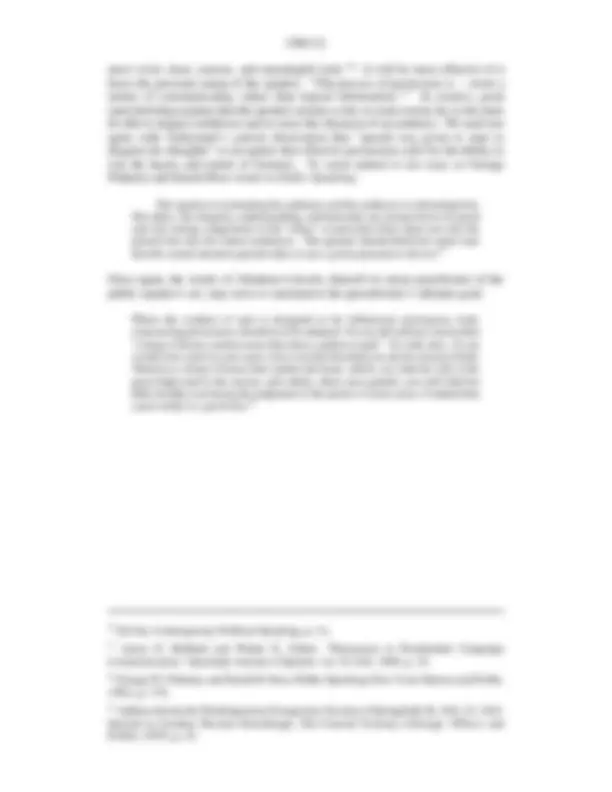


Study with the several resources on Docsity

Earn points by helping other students or get them with a premium plan


Prepare for your exams
Study with the several resources on Docsity

Earn points to download
Earn points by helping other students or get them with a premium plan
Community
Ask the community for help and clear up your study doubts
Discover the best universities in your country according to Docsity users
Free resources
Download our free guides on studying techniques, anxiety management strategies, and thesis advice from Docsity tutors
Insights into the art of speechwriting, focusing on the distinctive task of creating persuasive oral communication. It covers various aspects, including audience analysis, speech structure, and the use of poetic language and imagery. The document also discusses the importance of timing and entertainment in speeches.
What you will learn
Typology: Schemes and Mind Maps
1 / 26

This page cannot be seen from the preview
Don't miss anything!



















Order Code 98-170 GOV
Speechwriting in Perspective: A Brief Guide to Effective and Persuasive Communication
The frequent delivery of public remarks by Senators and Representatives is an important element of their roles as community leaders, spokespersons, and freely elected legislators. Congressional staff are often called on to help prepare draft remarks for such purposes.
Writing for the spoken word is a special discipline; it requires that congressional speechwriters’ products be written primarily, although not exclusively, to be heard, not read. Speeches are better cast in simple, direct, and often short sentences that can be easily understood by listeners. Rhetorical devices such as repetition, variation, cadence, and balance are available to, and should be used by, the speechwriter.
It is important for speechwriters to analyze audiences according to factors such as age; gender; culture; profession; size of audience; political affiliation, if any; and the occasion for, and purpose of, the speech. Most effective speeches do not exceed 20 minutes in length.
After researching a topic, speechwriters should prepare an outline from which the speech will be developed. They should strive to maintain a clear theme throughout the speech. Most speeches will have a three-part structure consisting of an introduction, a body, and a conclusion.
The accepted style of contemporary American public address is natural, direct, low key, casual, and conversational. This puts listeners at ease and promotes a sense of community between audience and speaker.
Punctuation should reflect the sound structure of the speech, reinforcing the rhythm and pace of actual speech. Clarity of expression is as important a consideration in speech grammar as rigid adherence to rules for written language.
Effective delivery can greatly improve a speech. Congressional speechwriters should make every effort to become familiar with the speaking style of the Member for whom they are writing, and adjust their drafts accordingly.
A wide range of speechwriting resources are available for congressional staff from the Congressional Research Service and other sources.
(^1) This report revises and expands an earlier report of the same title prepared by Charles H.
Whittier, Specialist in Religion and Public Policy, former Government Division.
1
“Rhetoric,” wrote Aristotle, “is the power of determining in a particular case what are the available means of persuasion.” This report reviews some effective means for the rhetoric of persuasive communication in speeches written by congressional staff for Senators and Representatives. By speeches, this report means draft statements prepared for oral delivery by Members. Such speeches are often prepared under the pressure of deadlines that leave minimal time for extensive revision. Moreover, they must often be drafted in whole or part for Members who may have little opportunity to edit and amend them. The burdens of public office (as well as of campaigning) and the insistent demand for speeches of every kind for a variety of occasions require some degree of reliance on speechwriters, a reliance that is heightened by the limitations of time and the urgencies of the media.
A speech thus “ghostwritten” should nevertheless reflect the intention and even the style of the speaker. The best ghostwriters are properly invisible; they subordinate themselves to the speaker in such a way that the final product is effectively personalized in the process of actual communication. The only ways to achieve or even approach this ideal are practice and experience. This report seeks to provide some guidance for congressional staff on the principles and practice of speechwriting. The suggestions offered herein, when combined with practice, attention to audience and occasion, and, most importantly, the Member’s attitudes, convictions, and style, can help create a speech that can be a “seamless garment” when delivered by the Member.
Writing effective speeches requires a constant awareness of the distinction between the written and the spoken word: the speechwriter must learn to “write aloud.” While the best speeches read as well as they sound, the novice speechwriter should give priority to the ear and not the eye. His or her speech must be written to be heard, not read.
(^5) Judith Humphrey, “Writing Professional Speeches,” Vital Speeches of the Day, vol. 54,
Mar. 15, 1988, p. 343.
! Franklin D. Roosevelt’s 1937 “One third of a Nation” speech imparted a sense of urgency by his deliberate repetition of a “here are” construction to describe conditions in the country, followed again and again with “now”:
Here is one-third of a nation ill-nourished, ill-clad, ill-housed — NOW. Here are thousands upon thousands of farmers wondering whether next year’s prices will meet their mortgage interest — NOW. Here are thousands upon thousands of men and women laboring for long hours in factories for inadequate pay — NOW.
Another venerable rhetorical device is the use of cadence and balance in the spoken word. This is a part of speechwriting where the speaker and the writer need cooperation to ensure success. The tradition of public speaking in the English language owes much to the poetic tradition, which was originally an oral tradition. As one observer noted, “the language of the speech should also be poetic — replete with alliteration, metaphor, and other figures of speech. Such adornments, far from being superfluous, enhance meaning and emphasize relationships among ideas.”^5 As difficult to define as to achieve, cadence and balance impart movement and harmonious effect to any speech. Essentially a matter of ordering groups of words (and ideas) into rhythmic patterns, cadence and balance can be attained by such classical rhetorical devices as the ones described below. Do not be put off by the classic Greek names of some of these rhetorical devices; in practice we use them naturally in conversation and writing every day.
Rhythmic Triads. The grouping of words into patterns of three can lead to a memorable effect, provided the device is not overused. Some notable examples from classic oratory include “ Veni, vidi, vici ”; “Never ... was so much owed by so many to so few”; “The kingdom, the power, and the glory ...”; “I have not sought, I do not seek, I repudiate the support of ...”; “one third of a nation ill-clad, ill- nourished, ill-housed....”
Parallelism. The linkage of similar words or ideas in a balanced construction that repeatedly uses the same grammatical form to convey parallel or coordinated ideas: “Bigotry has no head and cannot think; no heart and cannot feel;” “Charity beareth all things, believeth all things, hopeth all things, endureth all things.”
Alliteration. The repetition of initial sounds in a series of words to give emphasis. For instance, “We need to return to that old-fashioned notion of competition — where substance, not subsidies, determines the winner,” or, “... the nattering nabobs of negativism....”
Anaphora. This is the repetition of the same word or words at the beginning of successive clauses or sentences. Churchill’s famous defiance of Hitler, “We shall fight on the beaches, we shall fight on the landing grounds ...,” which has been previously cited, is one of the most famous examples.
Antithesis. A common form of parallel structure comparing and contrasting dissimilar elements. For instance, “... give me liberty, or give me death.”; “Ask not what your country can do for you — ask what you can do for your country.”; “To some generations much is given; from others, much is demanded ...”; “A great empire and little minds go ill together.”; “It was the best of times, it was the worst of times. It was the age of wisdom, it was the age of folly.”; “If Puritanism was not the godfather to Capitalism, then it was godson.”
This technique involves more than alternating longer sentences with short ones. The writer may employ either periodic sentences, that is, those in which the main clause comes at the end, or loose sentences, in which the main clause is presented at or near the beginning, to be followed by other main or subordinate clauses. Sentence variation also includes the use of such devices as those described below.
Rhetorical Questions. “Is peace a rash system?” “Is life so dear or peace so sweet as to be purchased at the price of chains and slavery?” The speaker leads the audience to the conclusion he hopes they will draw by asking a question that makes his point, and that he intends to answer himself, either immediately, with a flourish, or at greater length during his remarks, through patient exposition.
Sentence Fragments. “Dear money. Lower credit. Less enterprise in business and manufacture. A reduced home demand. Therefore, reduced output to meet it.” The speaker dramatizes the situation by reducing it to a stark declaration, which he renders more striking by pausing to let the facts sink in after each sentence fragment.
Inverted Order. “With what dignity and courage they perished in that day.” This classic rhetorical practice, once more widely used, seeks to embellish the general flow of words, much like an ornament or a musical flourish. It also helps give a particular sentence special emphasis by causing it to stand out from others by its unusual form.
Suspension for Climax. With this device, the speaker comes to a complete stop in his remarks, using the ensuing moment of silence to concentrate the listeners’ attention on his next phrase. “My obligation as President is historic; it is clear; yes, it is inescapable.” Even periodic sentences, if used with care, repeating the “suspended” subject or verb before modifying phrases or clauses can contribute to the effect: “Thus did he prove to be a leader who — victorious in battle, magnanimous in victory, skilled in the arts of peace — was able, in the face of his most determined foes ...”
(^7) Wiethoff, Writing the Speech, p. 22.
(^8) Ibid., p. 23.
Bates and others list a number of criteria useful in audience analysis, including, among others: age; gender; culture; education; profession ; size of the audience; and affiliation.^7 Age is obviously an important factor; high school students, young parents, and senior citizens have different levels of life experience, different interests reflecting the challenges they face at their particular stages of life, and, to some extent, they even speak different languages. Although gender differences in societal roles are less pronounced than a generation ago, some believe that certain persistent disparities of viewpoint between many men and women on some topics persist. With respect to “culture,” William Wiethoff, in Writing the Speech , states that it “has escaped a standard or preferred definition. Speechwriters, however, may envision culture as the race, customs, and religion shared by members of an audience.”^8 The factors of education, profession, and income level can be a pitfall for the unwary speechwriter. Never confuse education with intelligence, or professional status and worldly success with moral superiority or virtue, or modest means and educational attainment with the opposite.
The writer must be sensitive to these varying frames of reference found in an audience. Draft remarks should be familiar, sympathetic, and topical, without being condescending. They must, as always, be phrased in a way that is natural for the Member; it is painfully obvious to an audience if a Member is not comfortable in his role or with his words.
The size of an audience is another important factor in preparing a speech. A large audience and a formal occasion usually call for greater formality in language and delivery, lengthier remarks, and greater reliance on some of the classical rhetorical practices cited in this report. By comparison, many Members will require only talking points for a town meeting, and will almost certainly speak extemporaneously in still more intimate gatherings. In the age of cable and satellite television, and Webcasts, the Member is often asked to address what may appear to be a very small group of listeners physically present at the broadcast venue; at the same time, however, many others, perhaps thousands, may be viewing from other locations, or from their homes. It is the writer’s task to craft remarks that simultaneously take into consideration the people physically present in the studio or location, and those who may be watching from home or other locations.
Speechwriters must also condition their words to the degree of political affiliation, or lack thereof, in the intended audience. A gathering of the party faithful is usually ready for some “red meat.” An audience consisting of a non-partisan
(^9) Robert A. Rackleff, “The Art of Speechwriting,” Vital Speeches of the Day, vol. 54, Mar.
1, 1988, p. 311. (^10) Wiethoff, Writing the Speech, pp. 34-42.
citizen’s group, such as the League of Women Voters, is almost certainly not. The writer must also always remember that, while the Member is affiliated with one political party, and comes from a particular part of the state or district, he or she represents all the people, and gives due attention and respect to the legitimate views and aspirations of all constituents.
Occasion and Purpose
Another of the speechwriter’s tasks is to assess the occasion at which the Member has been asked to speak and tailor the remarks accordingly. In contemporary society, the delivery of remarks by public figures is an expected element in almost every secular public ceremony, and at many religious services. The speechwriter must ensure that the occasion and the speech agree with one another, in both tone and content.
For instance, Veterans’ Day and Memorial Day are among the most solemn public holidays in the calendar. For these two events, the speechwriter should focus on themes of commemoration, service, and sacrifice. The atmosphere should appropriately be both somber, and hopeful: “their sacrifice led to a better, more secure life for those who followed them.” High school and college commencements are of a different genre altogether. The occasion may demand inspirational remarks, but as one observer noted, “I’ve heard speakers ... deliver a tedious, solemn policy address at graduation ceremonies in which the graduates and families just want to hit the exits and have a good time.” 9 Conversely, a formal address to a learned society will differ dramatically from friendly remarks at a neighborhood picnic, town meeting, or retirement home. Simply put, the writer should exercise common sense in preparing remarks appropriate in tone and content to both the audience and the occasion.
Another useful consideration for congressional staff is to plan the delivery of substantive remarks on substantive occasions. If the Member is scheduled to announce a major policy statement or initiative, it should be delivered in commensurate surroundings, and on occasions when media coverage will be adequate. Timing is also a serious factor; speeches delivered at mid-morning, at lunchtime, or early afternoon at the latest, are far more likely to be covered that same day by local TV news.
The purpose of a speech and the occasion at which it will be delivered are closely related. Most frequently, the latter will govern the former. William E. Wiethoff suggests a “purpose” template for speechwriters in Writing the Speech.^10 In it he establishes three categories of purpose: information , persuasion , and entertainment.
(^13) Kenneth Roman and Joel Raphaelson, Writing That Works (New York: Harper and Row,
1981), p. 73.
these community rites, and a congressional speechwriter should devote talent and originality to them.
Obviously, the three purpose categories cited here are not necessarily mutually exclusive; in order to convince an audience, a speaker often needs to combine persuasion with information. Similarly, while some types of remarks are intended purely for entertainment, such as a celebrity roast, the careful speechwriter will always seek to entertain audiences in order to capture and retain their attention.
Time and Length
How long should a Member speak? The answer to this fundamental question of speechwriting, like so many others, depends on a wide range of factors. Audience analysis and occasion have been previously noted, but the habits and attitudes of the speaker must also be taken into consideration.
The natural inclinations of the Member must be examined. Is the Member a person of few words, or is he or she a good talker? Does the Member stick to the text, or lay it aside to share anecdotes, personal reminiscences, or even humor, with the audience? These and other related questions can be answered only through experience on the part of the congressional speechwriter. Learning the Member’s style and preferences will result in a better product that communicates more effectively.
Time of day should be considered by the writer. In the morning, people are relatively fresh, and are generally better prepared physically to listen attentively. By late afternoon, or after a luncheon, however, the audience may need to be stimulated, either by coffee or by lively remarks. Finally, lengthy after-dinner remarks should almost never be inflicted, especially on a paying audience. The potential auditors are full, tired, and ready to go home. It’s best to give them their wish as quickly as possible.
Finally comes the classic question: how many words should the speechwriter prepare? Once again, the factors of audience, occasion, Member preference, and time of day should be considered. The question of length of time, however, must be dealt with at some point. A number of classic speech authorities suggest that in most cases 20 minutes should be the upward limit. Conventional wisdom often holds that most listeners tune out, perceptibly or not, after that period. 13 Ritual or pro forma speeches, such as occasional remarks at schools, churches, or public functions where the Member is a guest, but not the main attraction, benefit from brevity, perhaps
(^14) For instance, in WordPerfect 12.0, click on “File;” select then “Properties,” and then
“Information” to obtain a word count. In Word, on the “Tools” menu click “Word Count.”
being limited to five to 10 minutes. Although substantive public policy speeches may merit greater length, in modern America, only presidential inaugural and State of the Union messages seem to exceed the 20-minute limit regularly, with the latter often weighing in at over an hour.
The question of pace is also important; is the Member a fast talker? Different speakers exhibit considerable variety in pace, ranging from 115 to 175 words a minute. Once again, the speechwriter will factor these personal differences into his work. As a benchmark, however, an often-cited rule-of-thumb is that the average 20- minute speech contains about 2,600 words, or, about 130 per minute. Most word processing programs will provide a total document word count as part of their spell check feature.^14
Having a fixed time stimulates careful preparation. Both a time limit and notes or text help guard against logorrhea , or excessive verbiage. Time limits also encourage speakers not to be overly comprehensive, saying everything there is to be said on the speech topic. This is a temptation difficult to resist, but a speech is, by nature, a precis or digest. Excessive complexity or verbiage are capable of transforming an effective speech into something ponderous and exhausting. Jefferson’s sharp judgment of 1824 applies today with equal force: “Amplification is the vice of modern oratory.... Speeches measured by the hour die with the hour.”
Speech Research
Theme, audience, time, place, occasion and purpose — once these are settled, the speechwriter’s next concern is to gather ideas, facts, examples, illustrations, quotations, and humor, in short, whatever is needed to give substance, character, and interest to the speech. There is no shortcut for researching a speech, although a number of resources can speed the process.
Speechwriting Resources
Congressional speechwriters often consult the Congressional Research Service first when preparing a draft statement or an address for a Member. CRS offers a range of speechwriting resources for the use of congressional staff, many of which are available from the CRS Home Page, at [http://www.crs.gov].
To find this report and other speechwriting resources, go to the CRS Home Page and click on the tab on the right, “Reference Desk” [http://www.crs.gov/reference/general/reference.shtml]. On the left side of the page you will find a link to “Speechwriting & Holidays/Commemorative Events” [http://www.crs.gov/reference/general/speechwriting.shtml]. This page provides links to commemorative speech materials, many of them focusing on major holidays, such
including many standard reference sources and CRS products. They are staffed full- time by information professionals available to assist you.
Legislative information is also available from commercial publications such as CQ Weekly , the annual Congressional Quarterly Almanac , and the same publisher’s eight-volume history of major legislation and national issues since 1945, Congress and the Nation. A journal of similar content but with greater emphasis on executive branch activities is National Journal , which appears weekly.
There are sites on the Web that may be helpful to the speechwriter.
American Rhetoric [http://www.americanrhetoric.com/index.htm] This is an Index to an expanding database of over 5000 full text, audio and video versions of public speeches, debates and interviews. This site has a useful set of communication links and is updated every two weeks.
Speechwriter.com [http://wwwthespeechwriter.com] This website contains many links to research sites, statistics, encyclopedias, business links, current events, anecdotes, quotes, speeches, toasts and biographies.
The Advanced Public Speaking Institute [http://wwwpublic-speaking.org/public-speaking-articles.htm] This website has 43 articles on the use of humor in a speech.
Additional helpful resources may include books on speechwriting. Writing Great Speeches: Professional Techniques You Can Use ( Essence of Public Speaking Series ), by Alan M. Pearlman, has endorsements from two public speaking groups, the National Speakers Association and Toastmasters International. You may also wish to consult a work by Richard Dowis, The Lost Art of the Great Speech: How to Write One — How to Deliver It. The author, a former journalist and public relations executive, discusses the content, the memorability, rule of three, and other speechwriting methods. Finally, Choosing Powerful Words: Eloquence that Works ( Essence of Public Speaking Series ), was written by Ronald H. Carpenter, a professor of English and communications. These books may be requested from the Loan Division of the Library of Congress, telephone 707-5441.
There are other basic materials with which every speechwriter should be familiar. These include a good standard dictionary (spell check is not foolproof, and has a rather limited vocabulary). The preferable dictionary is prescriptive as well as descriptive, that is, it prescribes or recommends usage in addition to providing descriptions or definitions. A thesaurus, such as Roget’s , published in numerous editions since 1852, or J.I. Rodale’s Synonym Finder , various editions since 1961, is useful in finding the right word and generally superior to the thesaurus feature offered with most word processing programs. For quotations, consult the standard Bartlett’s Familiar Quotations in any one of its many editions, or Respectfully Quoted , a quotation dictionary compiled by the Congressional Research Service.
Annual almanacs, such as the Information Please Almanac and the World Almanac , are often essential for quick reference.
Literary and religious sources include the works of Shakespeare in any readable edition and the English Bible, especially the King James or Authorized Version. Aside from its obvious spiritual aspects, the King James Bible is important for both its literary quality and its tremendous influence on spoken and written English.
Access to some standard encyclopedia, such as Americana , World Book or Britannica, is also helpful for fact checking and general information. Chase’s Calendar of Events is a useful annual guide to special observances throughout the nation. A wealth of facts, statistics, and data useful in speech preparation can be found in the annual U.S. Government publication Statistical Abstract of the United States , published annually. For sample speeches on many topics of contemporary interest, the speechwriter may wish to consult Vital Speeches of the Day , published twice monthly, available through EBSCO Host and other Internet sources. It provides examples of speeches delivered by recognized public figures on topical questions and major issues and events of the day, and is annually indexed by author and topic. All these sources are available in the La Follette Congressional Reading Room, and most are also available in House and Senate office building reference centers.
Daily newspapers are a familiar, if neglected, resource for speeches; a dedicated speechwriter will read or skim several each day, noting and saving background items that may prove to be useful later. Both national and hometown papers should be included. Other useful sources include weekly news magazines and more specialized journals that cover public policy issues. Here, again, the advent of the Internet provides new sources of information valuable to the congressional speechwriter: home district newspaper web sites may be regularly scanned for local news on issues and events of interest to the Member. These are usually posted online the day they are published, and almost always well in advance of postal delivery of the printed product.
Speech Preparation
Certain general principles may be useful to guide the congressional speechwriter in choice of content and style:
! Quotations and humorous anecdotes or remarks are like spices, and should be used with discrimination, mindful of good taste and effectiveness. Speeches overloaded with quotations and anecdotes can sink from their own weight.
! Pseudo-quotations should be avoided. Never use a quotation that cannot be verified in an authoritative source.
(^15) For a selection of presidential inaugural addresses, see: Jefferson’s first, 1801; Lincoln’s
second, 1865; Roosevelt’s first, 1933; Kennedy, 1961; and Reagan’s first, 1981. These and all others are available online at the CRS Home Page at http://www.crs.gov/. Click on the “Reference Desk” tab and select “Speechwriting & Holidays/Commemorative Events.”
added to as future occasions may require. President Ronald Reagan, for example, was legendary for his expert use and reuse of note cards that included facts and themes he sought to emphasize in various speeches.
Throughout the speech, the writer ought to be constantly asking: “What is it I am trying to say?” and, after it is written: “Have I, in fact, said it clearly, succinctly, and well?” Every speech seeks in some way to move an audience, to win support, to motivate, to convince, perhaps to inspire, or simply to entertain. Adhere to the central theme or idea while addressing it in different ways, much in the manner that good sentences are constructed for a paragraph.
The arrangement of ideas and themes should follow a logical progression. Each fact establishes a certain point, which leads to the speaker’s next point, and so forth, ultimately climaxing with the thematic conclusion. While it is more dramatic to gain an audience’s attention by opening a speech with a grand conclusion, be sure that the initial dramatic assertion is followed up by the essential process of weaving the argument the Member seeks to make.
Do not try to say too much, particularly when the speech is intended as the vehicle for a major announcement or initiative. The most memorable presidential inaugural addresses have been those that set a single theme, or coherent group of related themes. 15 Stick to no more than three major points, rather than attempting to say a little something about everything. Anything more risks running afoul of Churchill’s famous comment concerning a bland dessert: “This pudding has no theme.”
Three-Part Structure. Nearly every speech will have a basic three-part structure of introduction, body, and conclusion. An arresting introduction should lead into an emphatic statement of the main theme or themes. The argument that follows seeks to elaborate and develop the theme convincingly and effectively — that is, without too much detail. The central theme is restated in the closing peroration. One helpful approach for overcoming the feeling of word fright (what can I say and how?) is to write the speech in reverse: begin with the conclusion, which should summarize the central message, while abridging and restating whatever goes before. If the introduction sets the tone and establishes initial appeal or rapport, the closing communicates the final effect and is more likely to be remembered. Working backward is one way of imparting unity, coherence, and emphasis to the speech as a whole.
Techniques of Persuasion. There are many techniques available for the actual writing of a speech. Almost all speeches delivered by, or on behalf of, Members of Congress, even those for ceremonial or pro forma occasions, will have a certain political character because of the Member’s representative function, and also because of the way in which his or her office is perceived. In the rhetorical context, political means persuasive, including the expression of personal interest and concern, assuring and reassuring, conveying the Member’s identity with each audience, and so creating a community of interest and trust. Three kinds of persuasive techniques are usually distinguished:
! the appeal to reasonableness: “Surely Democrats and Republicans alike can agree that there is no excuse today for hunger in the world’s richest nation....”
! the appeal to emotion: “Can we, as a nation, close our eyes to the spectacle of millions of children going to bed hungry every night...?”
! the ethical appeal (that is, to the character of the audience): “our historic traditions of decency and generosity demand that we face squarely the question of hunger in America....”
All three approaches may be used in any given speech.
Attention-Problem-Solution. One popular option for developing a speech is the “attention-problem-solution” method, especially for longer speeches of a non- partisan character. Useful for many different occasions, this method begins by stimulating the interest of the audience, usually with attention-grabbing examples of a problem that needs to be recognized and confronted. The speaker then moves to define the “problem” situation, and concludes with the proposed “best” solution, presented so as to win listener support.
This or Nothing. Another option, the “this-or-nothing” method, advocates a policy mainly by presenting and refuting proposed alternatives as inadequate or worse. It lends itself well to partisan occasions or to stirring those already convinced. In every case the speaker seeks to reinforce and strengthen his principal ideas as they are unfolded in the speech. Prior audience analysis and subject preparation will often help the speech “write itself.”
No speaker should ever apologize for his or her presence, or for the content of the speech. If it truly deserves apologies, it is better left unsaid. Further, a prudent speaker, rightly wary of the impulse to speak “off-the-cuff,” will make certain that “extemporaneous” or “impromptu” remarks are not unprepared. For most speakers it is also better not to memorize a speech (unless one has a gift for it), since memory is fallible and elusive at best.
The congressional speechwriter should not shrink from commonly accepted contemporary usage: the all-day speeches and obscure classical allusions of Daniel Webster and Henry Clay make wonderful reading, but they are history. The